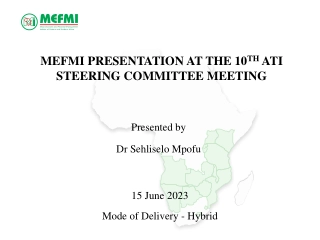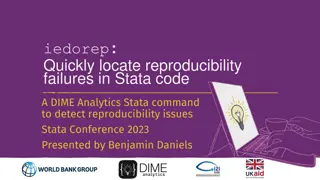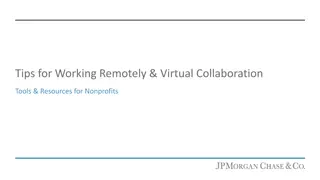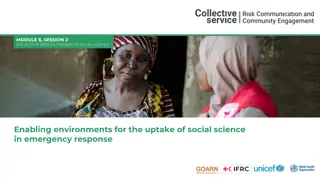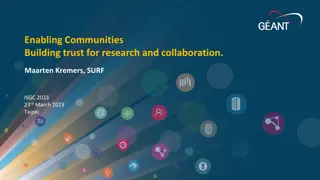BIRN: Enabling Collaboration on Someone Elses Dime
This article discusses the Biomedical Informatics Research Network (BIRN) and its role in facilitating collaboration in biomedical imaging research. It highlights the efforts led by Karl Helmer, Ph.D., at the Athinoula A. Martinos Center for Biomedical Imaging, Massachusetts General Hospital. The article sheds light on the importance of shared resources and funding in driving advancements in biomedical research.
Download Presentation

Please find below an Image/Link to download the presentation.
The content on the website is provided AS IS for your information and personal use only. It may not be sold, licensed, or shared on other websites without obtaining consent from the author.If you encounter any issues during the download, it is possible that the publisher has removed the file from their server.
You are allowed to download the files provided on this website for personal or commercial use, subject to the condition that they are used lawfully. All files are the property of their respective owners.
The content on the website is provided AS IS for your information and personal use only. It may not be sold, licensed, or shared on other websites without obtaining consent from the author.
E N D
Presentation Transcript
Biomedical Informatics Research Network (BIRN): Enabling Collaboration on Someone Else s Dime (mostly ) Karl Helmer Ph.D. Athinoula A. Martinos Center for Biomedical Imaging, Massachusetts General Hospital June 4, 2010
BIRN Research Networks The main goal of the BIRN is to enable collaborative bioscience/biomedicine Use Cases: - share data/tools - provide security - develop, add to, merge ontologies - query across disparate data sources - search for outside resources
BIRN Background Funded by National Center for Research Resources in 2001. Three neuroimaging testbeds initially provided use cases for developed technology. Reorganized in 2008 to provide software-based solutions for data sharing in the biosciences. No longer focused on neuroimaging (or even imaging). One can no longer log into BIRN . New model of providing modular capabilities that users can fit into existing toolset.
Technical Approach Bottom up, not top down Focus on user requirements - what they want to do Create solutions - factor out common requirements Capability model includes software and process Avoid Big Design up Front (BDUF)
Capability Model Software and services are only useful in bioinformatics if they do things that scientists need. What is the problem? How do the tools address the problem? BIRN s capabilities are defined in terms of problems and solutions, not in terms of software and services. This is true from beginning (definition and documentation) to end (quality assurance and assessment).
Dissemination Models Different problems require different kinds of solutions. BIRN operates services for all users; e.g., user registration service BIRN provides kits for project teams to deploy services for their members; e.g., data sharing BIRN provides downloadable tools for individuals to use on their own; e.g., image manipulation tools Understanding deployment needs is part of defining the problem to be solved.
Working With BIRN New capabilities are defined, designed, and disseminated by BIRN Working Groups Data Management Information Integration Knowledge Engineering Workflow Tools Security Genomics
Data Management BIRN seeks to support data intensive activities including: Imaging, Microscopy, Genomics, Time Series, Analytics and more BIRN utilities scale: TB data sets 100 MB 2 GB Files Millions of Files
Data Management Security Protect sensitive data: PHI, Researcher identity, IRB restrictions Scalability Support growth in projected data usage: data volumes, file sizes, users, sites, ops/sec Infrastructure Work with commodity networking, storage, etc.; and strict firewalls, etc.
Data Service Architecture Client Utilities Web Access Client Utilities UNIX utilities Java & C APIs Shared Services Manage File Locations Manage User Groups Local Services Integrate with conventional file systems Location Registry Group Management Policy Caching GridFTP Policy Enforcement Local File System Storage Service
Data Management Summary High Performance Transfer Protocol Strong security High performance, proven technology Group Management Centralized user and group management Caching at local servers Policy Enforcement Flexible access control policies User and group ownership rights Location Registry Distributed registry to track file locations Low overhead, supports 100s ops/s
Information Integration Mediator: uniform structured query access to heterogeneous sources Challenges: Syntactic (Access/Format) heterogeneity: Wrappers Structured Sources: DBMS, XML/XQuery DBs Semi-structured Sources: HTML, text, pdf Web services XML, SOAP, WSDL Semantic heterogeneity Mediator Schema Source modeling Data Record Linkage Scalability: Mediation Security Source Addition Record Linkage Efficient Query Execution Decision Support Application Programs Mediator Databases Knowledge Bases Computer Programs The Web
Information Mediator Virtual Integration Architecture: Virtual organization: community of data providers and consumers that want to share data for specific purpose Autonomous sources: data, control remains at sources; no change to access methods, schemas; data accessed real-time in response to user queries Mediator: integrator defines domain schema and describes source contents Domain schema: agreed upon view of the domain preferred by the virtual organization Source descriptions: logical formulas relating source and domain schemas
Information Mediator Query Answering User writes query in domain schema Mediator: Determines sources relevant to user query Rewrites query in sources schemas Breaks query into sub-queries for sources Optimizes query evaluation plan Combines answers from sources Efficient query evaluation Streaming dataflow
Information Mediator User queries Domain Schema Logical Source Descriptions Reformulation Optimizer Mediator Execution Engine Sources schemas Wrapper Wrapper Data Source Data Source Data Source 17
Mediator Use Case - CVRG Domain query Integrated results Same BIRN mediator Just plug in CVRG source descriptions Logical Source descriptions BIRN Mediator WaveformDB (eXistDB XML DBMS) ECG_Mesa (MySQL DB) and additional wrapper for eXistDB (XML/XQuery database) DICOM Image Files (file system) Waveform Files (file system) Chesnokov Analysis (eXistDB XML DBMS) Image Metadata dcm4che PACS (MySQL DB)
Knowledge Engineering Ontology development challenges: Modeling complex domains is challenging and requires specialized expertise The community of ontology development efforts is large and somewhat daunting to navigate Our goal: to provide an ontology development process that leverages existing ontology development creates effective dialog between domain users and biomedical ontologists informs and documents the design of domain models for integration publishes curated domain ontologies to the community
BIRN Security Vet new user request for community membership Provide new user identity Provide single sign-on for users Manage access control policy Enforce access policy on resources Manage user groups for projects within community Address potential security issues
BIRN Security Hosted services for common requirements Tools and clients for integration with community resources Security Vulnerability Handling System Expertise and consultation for community application integration
Function BIRN Security BIRN Identity Provider Username/ password FBIRN Site 1 GridFTP Server BIRN Registration Service BIRN Credential Service FBIRN Site 2 GridFTP Server X.509 Certificates BIRN Portal Username/ password BIRN Credential Service Clients Administrator End User
BIRN Best Practices Consulting We need 8, 40 GB uploads and 4, 10 GB downloads simultaneously is achievable. We need to transfer data is not. Data provenance, data curation, best practices, federated versus repository What does it take to get things done?
Working with BIRN Projects are vetted by BIRN Steering Committee for appropriateness and resource planning Collaborators are expected to be actively involved in development and deployment. Collaborators are not expected to use complete BIRN capability kit.
Summary BIRN provides a capability kit and consulting to facilitate internal and external data sharing. BIRN takes a bottom-up, modular, capability- based approach that is driven by end user needs. End users are viewed as collaborators and are actively involved in development process.
BIRN Program Announcements Provides funds to work with BIRN on projects relating to data sharing (PAR-07- 426) and the associated ontology (PAR-07- 425) for the data. Mechanism to fund the leveraging of BIRN capabilities BIRN provides assistance in framing proposals.
Contact Information Email address: info@birncommunity.org BIRN Representatives Joe Ames: jdames@uci.edu Karl Helmer: helmer@nmr.mgh.harvard.edu Seth Ruffins: sruffins@loni.ucla.edu Web site: www.birncommunity.org
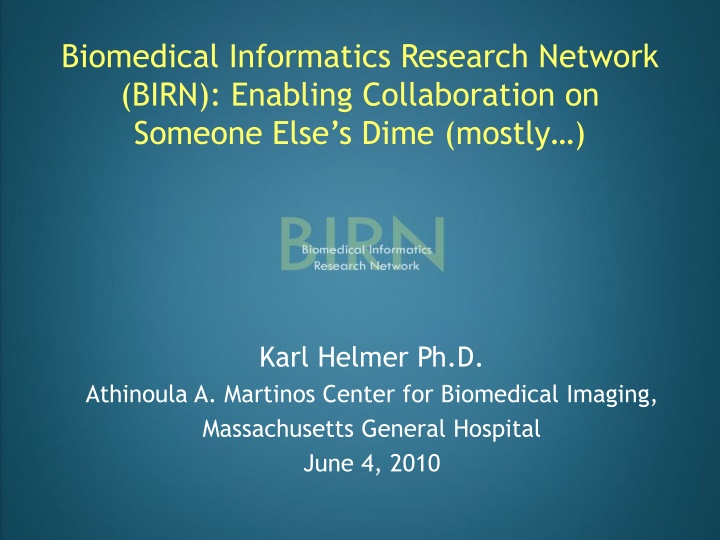


![❤[PDF]⚡ Zee Zee Does It Anyway!: A Story about down Syndrome and Determination](/thumb/20462/pdf-zee-zee-does-it-anyway-a-story-about-down-syndrome-and-determination.jpg)

